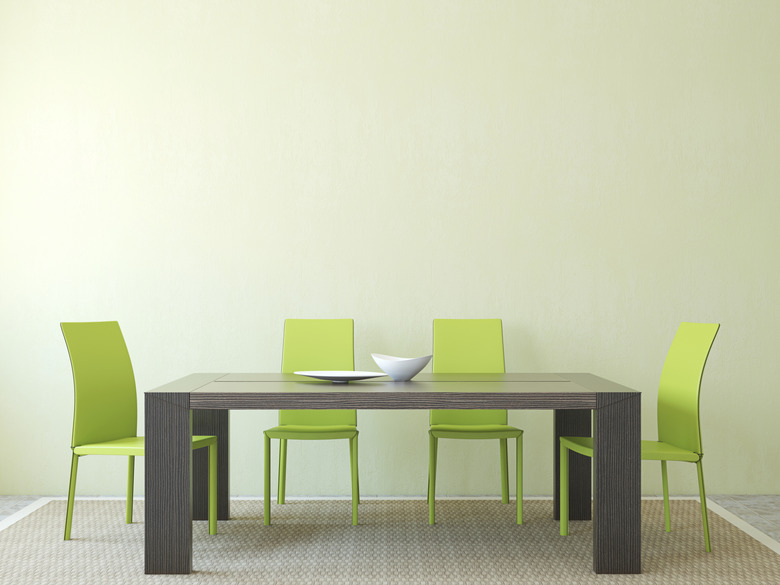How To Make A Mint Green Color
Basic color theory provides all the hints you need to make mint green, whether you're decorating your guest room or a dozen cupcakes. Mix equal parts of two primary colors — blue and yellow — to get green. Then add white to lighten the green until it is a pale, cool minty tint. Adjust the color as you mix by adding minute amounts of yellow to a green that is too blue and tiny dabs of blue to a green that isn't light enough.
Freshly Minted
Freshly Minted
Add plenty of white to mint wall paint to "bleach" it to a pale hint of color that is still assertive enough to challenge a complementary hue. Red and green are opposites on the color wheel and will harmonize for lively contrast in a room when you play with intensities and patterns. The faintest mint walls, white ceiling, ebonized wood floors and a red Murano glass chandelier set the stage for a quirky modern room with a pair of club chairs upholstered in skinny red stripes on white; pink, white and charcoal checked floor-length drapes; a slouchy charcoal sofa with a clear acrylic coffee table; and a mint, pink, red and dove-gray abstract area rug.
Maximum Mint
Maximum Mint
Imagine slipping into a cool pond in a mossy forest glen. Light filters softly through the green leaves. Dark green ferns stir in a faint breeze. It's very peaceful, in fact, peaceful enough to be your spa-like bathroom when you mix light mint green walls and towels with a host of more saturated greens. The countertop is faux malachite; the floor is a symmetrical mosaic of forest-green and white penny tiles. A stained glass panel in the window is wavy, watery lime, emerald, grass-green and teal. If you work within a family of greens, vary the saturation, but keep most shades in the same fresh clear green of mint. Use adulterated shades such as teal or a 2015 Pantone Color Institute seasonal favorite, Lucite, as accents.
Vintage Mint
Vintage Mint
A traditional kitchen has all the charm of the early 20th century and all the zest of bright, clean mint green when the walls are cream and the cabinets are painted with creamy mint-green milk paint. Linoleum floors, reproduction period hardware and glass ceiling lamps, and old-fashioned appliances — designed for your grandma but made to energy-saving standards — will have you whipping up Sunday roast chicken and apple pie. Some reproduction appliances can be ordered in light mint-green enamel. Try a different tack for a similar result when the wide plank floors are bleached and the cabinets and ceiling are oyster white. Paint all the trim, doors and built-in breakfast booth mint green with low-gloss or very glossy paint, so fingerprints and smudges wipe right off. Remember that a glossy finish will make the paint color seem brighter.
Finger-Lickin' Mint
Finger-Lickin' Mint
Mint-green is refreshing and yummy enough to eat, so dig in. Add a few drops of pure green food coloring to a big bowl of buttercream icing and slather it over the St. Patrick's Day cupcakes for the third-grade bake sale. Another drop or two of green in vanilla pudding makes minty-looking leprechaun parfait when you layer the pudding with crumbled brownies in a glass serving dish. Make your Christmas peppermint bark in holiday colors by tinting the white chocolate mint green before assembling the crushed peppermint and two chocolates. If you're frosting a summer picnic lemonade cake, add three scant drops of green food coloring for every 1/2 cup of white frosting; swirl the mint-colored sweet stuff over the top and sides of the cake, and decorate the top with sprigs of crystalized mint leaves.
